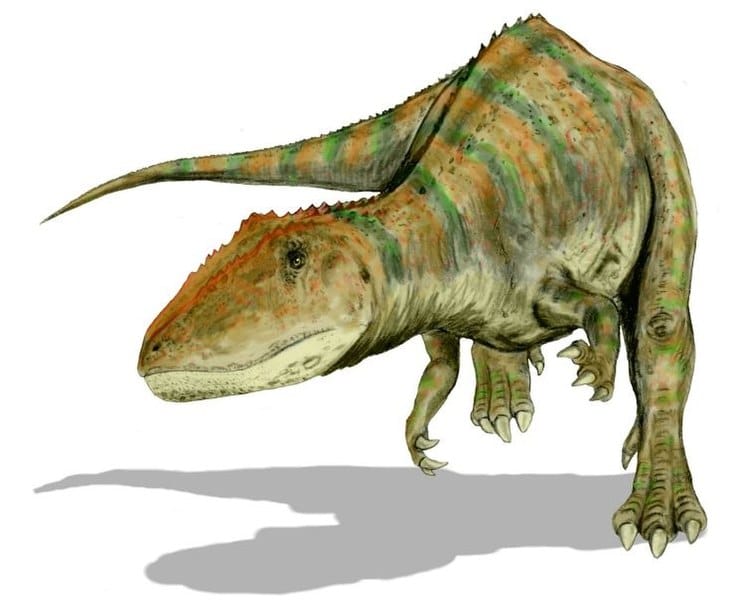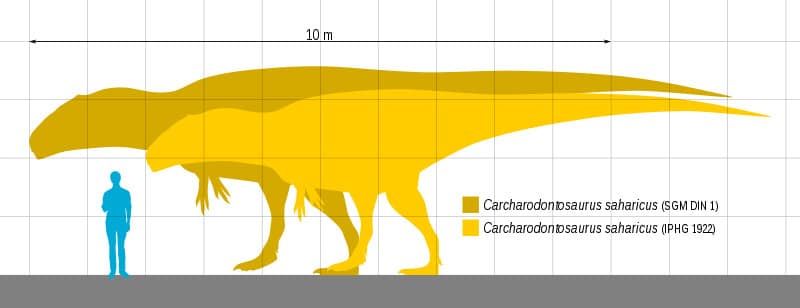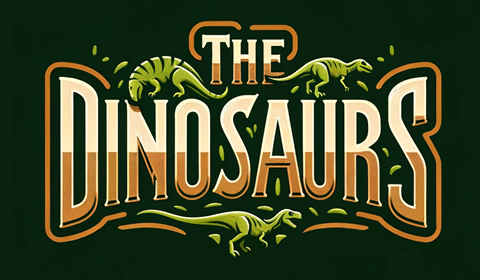Carcharodontosaurus was a giant carnivore theropod, roaming Earth during the Late Cretaceous. This remarkable creature whose name means “sharp-toothed lizard” was a sight to behold, rivaling even than the infamous T-Rex in size. Its existence provides us with a unique window into the past and offers insights into a world that was dramatically different from our own.
Key Facts
| Keyword | Fact |
|---|---|
| Carcharodontosaurus pronunciation | kaar-kr-uh-daan-tuh-saw-ruhs |
| Meaning of name | Sharp-toothed lizard |
| Group | Theropod |
| Type Species | Carcharodontosaurus saharicus |
| Diet | Carnivore |
| When it Lived | 129.4 to 70.6 MYA |
| Period | Late Cretaceous |
| Epoch | Barremian to Middle Campanian |
| Length | 49.0 ft |
| Height | 14.1 ft |
| Weight | 6.0 to 15.0 tons |
| Mobility | Moved on two legs |
| First Discovery | 1924 by Charles Depéret and Justin Savornin |
| Location of first find | Algeria, Africa |
| First Described by | 1925 by Charles Depéret and Justin Savornin |
| Holotype | UCRC PV12 |
Carcharodontosaurus Taxonomy and Timeline

This dinosaur’s name comes from the Greek words “karcharos” meaning “jagged” or “sharp,” “odōn” meaning “teeth,” and “sauros” meaning “lizard.” In essence, Carcharodontosaurus translates to “sharp-toothed lizard,” a fitting name for this carnivorous beast.
This carnivorous dinosaur belongs to the Theropod group, specifically the Carcharodontosauridae family. There are two known species of this dinosaur: Carcharodontosaurus saharicus and Carcharodontosaurus iguidensis.
The timeline of Carcharodontosaurus is quite fascinating. This dinosaur lived during the Late Cretaceous period, specifically from the Barremian to the Middle Campanian epoch. This means that Carcharodontosaurus roamed the earth between 129.4 and 70.6 million years ago.
Listen to pronunciation
Now, if you’re curious about how to pronounce this dinosaur’s name, we’ve got you covered.
Discovery & Fossil Evidence
The first evidence of this dinosaur was discovered in 1924 in Algeria, Africa by French paleontologists Charles Depéret and Justin Savornin. They found two teeth that had unique characteristics that led them to describe a new taxon. The teeth were initially attributed to a species they named Megalosaurus saharicus.

Later, more completeCarcharodontosaurus fossils were found in various locations including Brazil, Egypt, Morocco, Niger, and Tunisia. These finds have helped to paint a more comprehensive picture and contributed to our understanding of its physical characteristics.
Carcharodontosaurus Size and Description
Before we delve into the specifics, let’s take a moment to appreciate the sheer magnitude of Carcharodontosaurus. It was a large, almost giant theropod. Theropoda is a group of dinosaurs characterized by their hollow bones and three-toed limbs, where you find m,ost of the famous dinosaur predators.
Its body was built for hunting, as seen by its long, muscular tail for balance, powerful hind limbs for chasing down prey, and short but robust arms equipped with sharp claws.
The head was massive, housing its most distinctive feature: its teeth. These were long, serrated, and incredibly sharp, perfect for tearing into the flesh of its unfortunate victims. As for its skin, no direct evidence exists but it’s generally believed that it was covered in scales like many theropods.
Size and Weight of Type Species

This was one of the largest carnivorous dinosaurs that ever lived. It is believed to have reached lengths upwards of 49 feet, and stood 14 feet tall. Estimates of its weight vary a bit, but they are in the range of 6 to 15 tons.
These figures, while impressive, should be taken with a grain of salt as they are based on extrapolations from incomplete fossil evidence. Nonetheless, there’s no denying that Carcharodontosaurus was a colossal creature and a true testament to the awe-inspiring scale of life in the Late Cretaceous period.
The Dinosaur in Detail
Carcharodontosaurus was a creature perfectly adapted to its environment and role as a top predator. Its most striking feature was, of course, its teeth. These were not just sharp; they were designed for maximum efficiency in tearing flesh, allowing it to feast on the abundant herbivorous dinosaurs of its time.
But the teeth were not the only remarkable feature of Carcharodontosaurus. Its skull was uniquely designed with a series of fenestrae or openings that reduced weight while providing space for muscle attachment. This design allowed for a large, powerful jaw without the need for a heavy, cumbersome skull.
It also had a robust and muscular body with a long tail that helped it maintain balance while running at high speeds. Its hind limbs were powerful and built for speed while its smaller forelimbs were equipped with sharp claws for gripping prey. These features were combined with its keen senses and predatory instincts and made it a formidable hunter.
Carcharodontosaurus in its Natural Habitat
This carnivore occupied a world vastly different from our own. The Late Cretaceous period was a time of warm climate and high sea levels. The landscape of Africa and South America was dominated by flowering plants—a relatively new development in Earth’s history—and the first true birds were taking to the skies.
As a carnivore, this dinosaur was at the top of the food chain. Its diet likely consisted of large herbivorous dinosaurs, such as Ouranosaurus. Its sharp teeth and powerful jaws would have made short work of any prey unlucky enough to be caught. It was bipedal and moved on two powerful hind limbs. This as well as its long tail for balance would have made it a fast and agile predator capable of chasing down even the swiftest of prey.
It was not the only large predator in its environment. Fossils of this dinosaur have been found in the same areas as those of the Spinosaurus and the Sarcosuchus, suggesting that these three large carnivores may have been competitors. Despite this competition, Carcharodontosaurus was likely the apex predator in its ecosystem, its size and power unmatched by any other creature.
Interesting Points about Carcharodontosaurus
- It had some of the largest known carnivorous dinosaur teeth, which could reach lengths of up to eight inches.
- Despite its size, it was likely a fast runner and estimates suggest it could reach speeds of up to 20 miles per hour.
- It is known from several well-preserved specimens, including a nearly complete skull, which has provided valuable insights into its anatomy and lifestyle.
- It lived alongside several other large carnivorous dinosaurs, including the Spinosaurus and the Abelisaurus.
- This is one of the few dinosaurs whose discovery and description were significantly impacted by World War II, as the original fossils were destroyed during bombing raids.
Contemporary Dinosaurs
This apex predator shared its world with a fascinating group of contemporaries. Among these were the African dinosaurs Spinosaurus, Rugops, Paralititan, and Ouranosaurus. Each of these dinosaurs, whether predator or prey, contributed to the intricate dance of existence in their own unique ways.
Spinosaurus might have been a formidable competitor to Carcharodontosaurus, though its diet focused mainly on fish. Their potential encounters could have been a clash of titans, a testament to the survival of the fittest. Yet Carcharodontosaurus, with its robust build and powerful jaws, was no less a force to be reckoned with.
Rugops, another contemporary, presents an interesting contrast. While smaller than Carcharodontosaurus, it was still a carnivore and their paths might have crossed in the pursuit of similar prey. This dynamic paints a vivid picture of the challenges and competition Carcharodontosaurus faced in its daily life.
Paralititan and Ouranosaurus were both considerably smaller and were likely part of Carcharodontosaurus’s diet. These herbivores, while not as physically imposing, played a crucial role in the ecosystem and shaped the environment that Carcharodontosaurus called home. Their existence and potential interactions with our dinosaur provide a glimpse into the complex food web of the time.
In this intricate web of relationships and interactions, Carcharodontosaurus stood as a central figure, its life deeply intertwined with those of its contemporaries. This exploration offers a glimpse into the complex and fascinating world that these magnificent creatures inhabited.
List of All Dinosaurs
We have created a list of all dinosaurs we have covered here, sorted across the seven main groups of dinosaurs. We also include information about their type of diet, (omnivore, herbivore or carnivore) and the time they lived.
Frequently Asked Questions
The name translates to “sharp-toothed lizard,” a fitting name for this carnivorous dinosaur with its long, serrated teeth.
It lived during the Late Cretaceous period, specifically from the Barremian to the Middle Campanian epoch, which means it roamed the earth between 129.4 and 70.6 million years ago.
As a carnivore, it likely preyed on large herbivorous dinosaurs. Its sharp teeth and powerful jaws would have allowed it to tear into the flesh of its prey with ease.
It was one of the largest carnivorous dinosaurs that ever lived. It could reach lengths of up to 49 feet and weigh between 6 to 15 tons.
Fossils have been found in various locations, including Algeria, Brazil, Egypt, Morocco, Niger, and Tunisia.
Sources
- https://bioone.org/journals/journal-of-vertebrate-paleontology/volume-27/issue-4/0272-4634_2007_27_902_ANSOCD_2.0.CO_2/A-NEW-SPECIES-OF-CARCHARODONTOSAURUS-DINOSAURIA–THEROPODA-FROM-THE/10.1671/0272-4634(2007)27[902:ANSOCD]2.0.CO;2.short
- https://www.tandfonline.com/doi/abs/10.1080/08912961003625657
- https://www.ppegeo.igc.usp.br/index.php/rbg/article/viewFile/7892/7319
- https://www.researchgate.net/publication/276225463_Teeth_of_Abelisauridae_and_Carcharodontosauridae_cf_Theropoda_Dinosauria_from_the_Campanian-Maastrichtian_Presidente_Prudente_Formation_Southwestern_Sao_Paulo_State_Brazil
- https://pubmed.ncbi.nlm.nih.gov/24869965/
Featured Image Credit: Fred Wierum, CC BY-SA 4.0, via Wikimedia Commons
